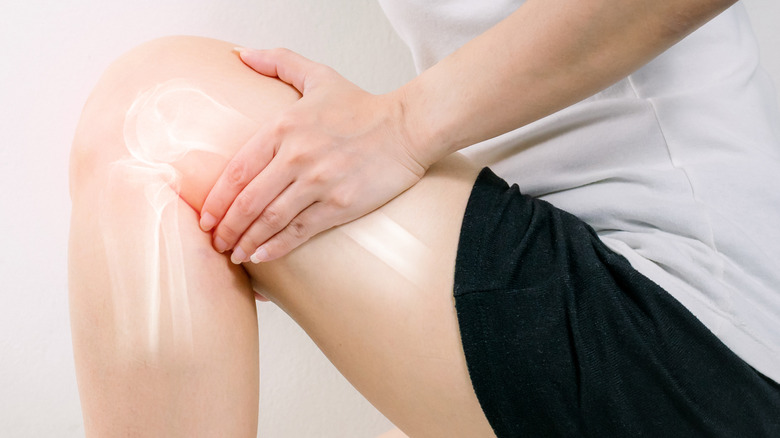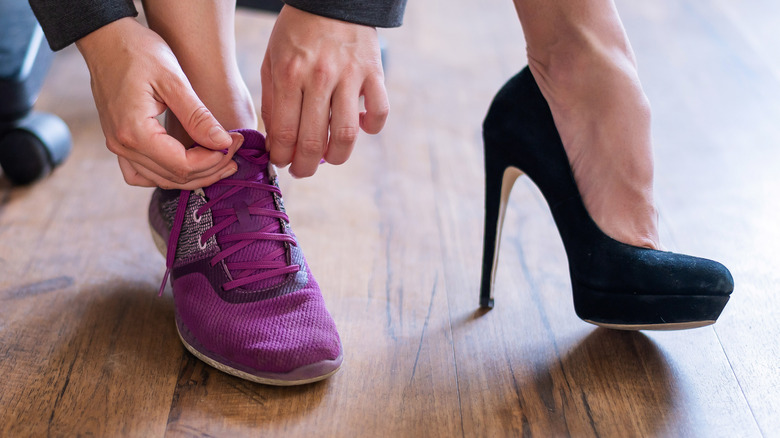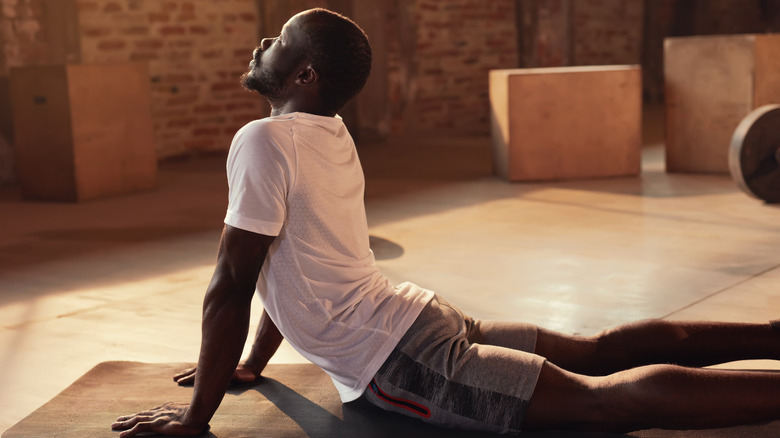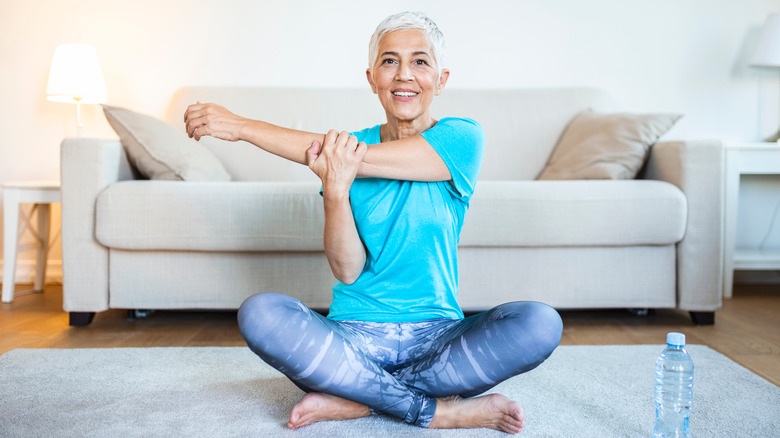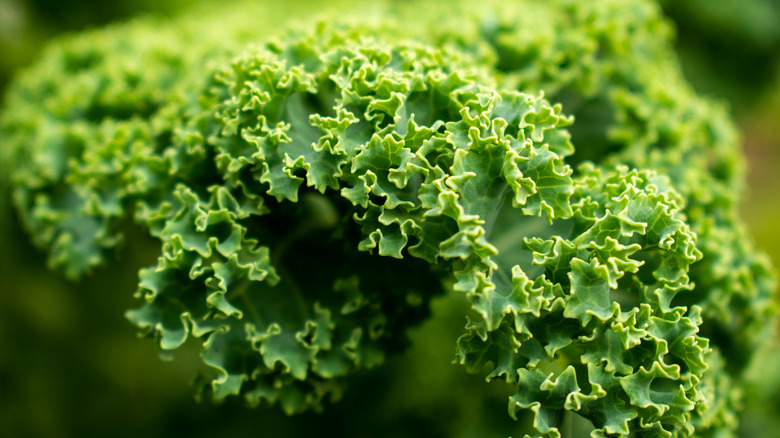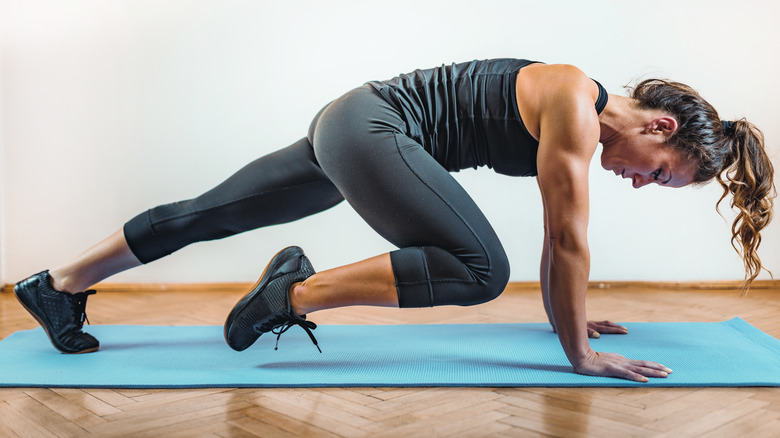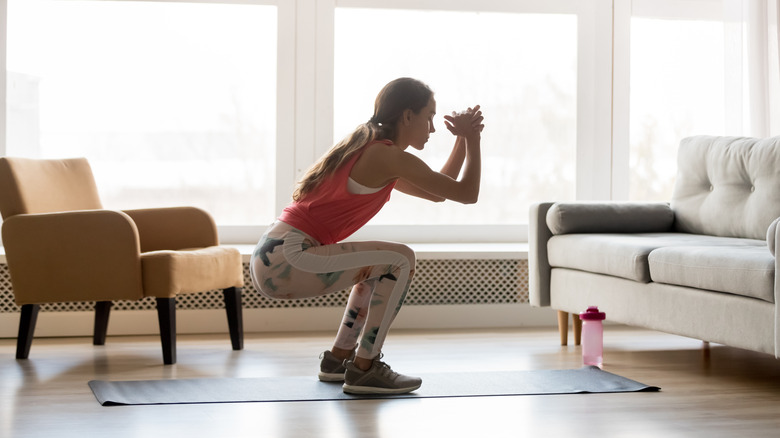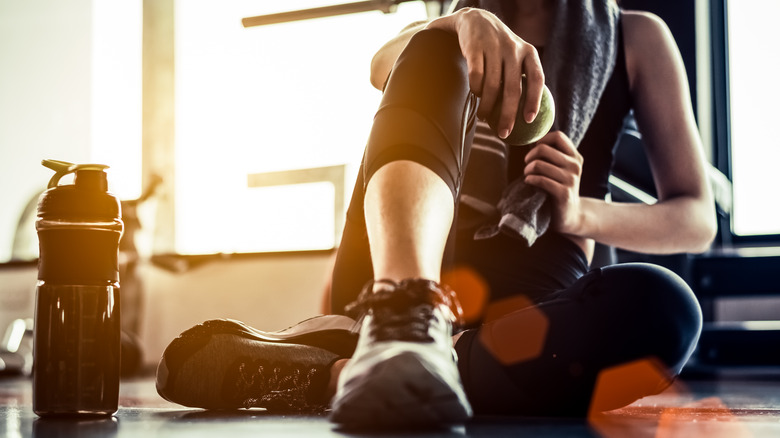Mistakes That Are Doing Damage To Your Joints
Where would we be without our joints? The natural hinges of our body serve to move us through countless everyday functions, from the finger joints that are involved in you scrolling through this article to the atlanto-occipital joint involved in you nodding your head sagely at the wisdom contained within (hopefully). There's no denying that these joints take on a huge amount of stress, and are particularly susceptible to damage over time. And, with 22.7% of the American adult population suffering from arthritis (per the CDC), caring for our joints is essential, particularly in later life.
This is why it's vital to avoid making mistakes that can damage our joints. Unfortunately, there are a large number of factors, from the shoes we choose to the diet we eat, that can affect our joint health. What's more, a lot of this damage can be slow-burning and can occur without symptoms — and, before you know it, it's too late. As such, here at Health Digest, we've put together some of the top mistakes that could be doing damage to your joints, to help you identify any key offenders in your lifestyle.
You're wearing high heels too often
Your high heels may look incredible, but your joints aren't going to thank you for them. Experts from The Society of Chiropodists and Podiatrists advise that wearing high heels can cause increased pressure on your foot, knee, and ankle joints by adapting the body's posture to an unnatural position, and this pressure can increase the risk of both joint injury and osteoarthritis. Despite this, a 2,000-person poll conducted by the society found that a quarter of women wear high heels either frequently or every day.
Instead, the advice is to opt towards footwear that can provide support and comfort for your joints wherever possible. "Choosing the right footwear will help minimize the stress placed on the feet and joints during everyday activity, and helps reduce the risk of injury and joint damage," states arthritis researcher for the UK-based society and podiatrist Professor Anthony Redmond to BBC News. "For daily wear, the recommendation is to opt for a round-toed shoe with a heel height of no more than 2-3cm (one inch) and with a shock-absorbent sole to help minimize shock to the joints." In addition, Redmond recommends choosing suitable footwear when you exercise, with trainers designed specifically for sporting activity.
You're exercising too repetitively
It's all too easy to fall back on our regular workout routines, particularly when we just want to get some exercise done. It's equally easy to overdo this, however, and exercising too repetitively can cause some serious damage to our joints, advise certified personal trainers Jen Mueller and Nicole Nicholls for Spark People. By undertaking the same exercise day in and day out (particularly high-impact exercises like running or plyometrics), you're working your muscles and joints in the same manner and, over time, this can lead to not only injury, but a wearing down of the cartilage in your joints.
This is why Mueller and Nicholls recommend trying to switch up your exercise routine wherever possible, to help keep injury at bay and to keep your joints moving in different directions, keeping them healthy. This is as important if your joints are unaffected by arthritis as if they are. If you're working out with arthritis, Arthritis Health also recommends varying your routine and making purposeful, controlled movements when you exercise, helping to strengthen the muscles around your joints and increasing stability and durability.
You're not stretching enough
Stretch, stretch, stretch. That's the mantra in pretty much all exercise, sure, but particularly when it comes to joint health. When we stretch, we help to give our muscles a wider range of motion, which then means they're better equipped to handle exercise (particularly aerobic exercise), says the Arthritis Foundation. This is particularly important when it comes to stiff joints.
The Arthritis Foundation states that hamstring stretches are especially crucial to maintaining joint health, due to the knee or hip misalignment that can occur when exercising with a tight hamstring. Hip misalignment is generally a condition that occurs over time and can lead to a wealth of other potential injuries, like a hamstring strain, runner's knee, and hip injury, as well as large amounts of pain, The Joint Chiropractic states. Should you suspect you're suffering from hip misalignment (which can often be identified by a sense of misbalance or one leg being shorter than the other), it's important to seek treatment from a chiropodist. Once your misalignment is treated, regular massages, strength training in affected areas, and stretching are all useful ways to prevent further issues.
You're not getting enough omega-3 fats
The health benefits of omega-3 fatty acids, like those found in your everyday fish oil supplement, or salmon or other fatty fish, are pretty hard to overstate. Regular consumption of these fats can contribute to improved mental health, lower risk of cancer, and a lower risk of heart disease, according to Healthline. And they don't stop working there: omega-3s are powerful allies in the fight for joint health, arthritis prevention, and a reduced incidence of joint pain.
This is all down to omega-3 fatty acids' effectiveness in reducing chronic inflammation, which is the primary cause of arthritis. One study published in the Global Journal of Health Science found that there was a significant reduction of symptoms of rheumatoid arthritis in patients taking a daily omega-3 supplement for just 12 weeks. This is just one study of a huge wealth of clinical information showing the efficacy of these wonder fats, as this review in the Mediterranean Journal of Rheumatology shows. Diets like the Mediterranean diet, or those rich in fatty fish, can be a great way to get these acids; plant sources like chia seeds and walnuts are also great ways to get your daily intake, says Healthline.
You're drinking too much coffee
We know this one might be a little hard to stomach, but those empty coffee cups littered over your desk? They might be causing your joints a little aggro that you don't even know about yet. Unfortunately, this is far from a clear-cut scenario, as results on research on the link between coffee and rheumatoid arthritis have been conflicting. One extensive report published in the Annals of the Rheumatic Diseases, for example, concludes that coffee consumption should be considered a possible risk factor or a confounder in future research into the cause of [rheumatoid arthritis], although it struggled to pinpoint the exact mechanism behind why this was.
However, another, more recent review, this one published in the journal Nutrients, hypothesizes that coffee, in and of itself, may not be a direct cause of arthritis or joint pain. Instead, it indicates that the caffeine in coffee has anti-inflammatory effects which may help to reduce joint issues or prevent damage. The review also points out, however, that other lifestyle factors that come with drinking too much coffee (like poor sleep and the high fat or sugar content that can come with some coffee drinks) might contribute to joint aches.
You're not paying attention when you lift heavy objects
Sounds obvious, right? To really focus when you're picking up something super-heavy? Well, this is something that's actually much easier said than done, particularly if you're a frequent gym-goer who's got it down; but, by not paying attention, you're causing your joints some serious stress. "Weight training (and lifting objects in general) can increase stress placed on joints," says John Hopkins School of Medicine's assistant professor of physical medicine and rehabilitation Alex Morgan Coslick to Livestrong. By not focusing while you do so, you can place unnecessary stress on joints that, with one sudden or ill-thought-out movement, can lead to acute and/or chronic injury.
As such, keeping your attention is crucial. "With the initiation of an exercise program, it is essential to focus on form and good neuromuscular control," says Coslick. If you're just starting on an exercise program, start slow and light, and make sure you're nailing your form before you start to go too heavy. "The same general principles should be applied for lifting heavy household items," Coslick advises. So, next time you're moving house, make sure to take it slow on those boxes and ask for help if you need to.
You're not drinking enough water
We feel like this one could be the general answer to most problems in life, but not drinking enough water can, aside from causing various other issues, also be particularly problematic for our joints. This is primarily down to the composition of our joints, in which water plays a large part. Water is important for creating synovial fluid in the joint, which helps lubricate the joint and increase growth of new cells in cartilage," says registered dietitian Leslie Langevin, co-owner of Whole Health Nutrition and the author of "The Anti-Inflammatory Cookbook" to Livestrong.
What's more, not drinking enough water can contribute to and aggravate arthritis in areas of our body that aren't our joints. "We know that rheumatoid arthritis and psoriatic arthritis involve other organs, and we know hydration is important for the protection of our heart, our skin, and other organs, so it's also good to stay hydrated to allow good blood volume to those organs," Magdalena Cadet, a clinical rheumatologist and NYU Langone Health's associate attending physician, told Creaky Joints. "Hydration also helps your muscles function properly, and we need our muscle function to help with our joint function." The interconnectedness of these conditions basically means that everything benefits from more water.
You're not warming up before exercise
How many times have you set out on a run and felt a twinge of pain? If you're like us, quite a few — and these pains could end up being pretty problematic, if you don't regularly warm up. When we warm up lightly before exercise, we increase the blood flow throughout our bodies and to our muscles, making them more capable to support our joints, as well as loosening up the joints themselves, as Tri-City Medical Center states. Stretching can also help with this, to get your body into a state of preparedness. All of these things help us to avoid injury, which can lead, in some cases, to lasting damage.
While it's important to warm up properly even if you don't have arthritis, if you do have it (or have joint pain in general) warming up is even more crucial, as is exercise in general. For people with arthritis, exercise is vital to help to reduce joint pain, fight against fatigue and tiredness, and increase flexibility, as the Mayo Clinic states. Additionally, exercising can help to build up the muscles around your joints, protecting them further, as well as helping to maintain your bone strength. Although it can be challenging to exercise with arthritis, confer with your doctor about the best approach for you.
You're not getting your greens
We're sorry to sound like your parents on this one, but it's true. Your greens, and multiple other fruits and vegetables, are pretty vital for joint health, and not eating them may be causing those joints unwitting damage. "Each deeply-colored vegetable or fruit provides a great source to help reduce inflammation in our bodies, including our joints," explains registered dietitian Leslie Langevin, co-owner of Whole Health Nutrition and the author of "The Anti-Inflammatory Cookbook" to Livestrong. Fruit and veg have particularly strong anti-inflammatory effects due to their often-high levels of antioxidants, of which Healthline gives various examples.
If you're concerned about your joints, either now or in the future, prioritizing certain vegetables which have particularly powerful anti-inflammatory effects is a good place to start. Langevin, like us, recommends greens, particularly dark, leafy variants like kale and bok choy, for their dense content of vitamins A, C, and K, and antioxidants, which have anti-inflammatory effects. Cherries are also an excellent choice when it comes to joint health. Consuming cherries regularly has been observed to reduce the symptoms of both arthritis and gout, as a review from Therapeutic Advances in Musculoskeletal Disease shows.
You're doing too many HIIT workouts or intense sports
Sometimes, only a hard workout will do. Be careful how often you do intense exercise, though, as overdoing it can over time cause your joints to suffer badly. HIIT (high-intensity interval training) workouts, a stay-at-home favorite during the COVID-19 pandemic for their ability to be done easily in your bedroom, are a particular culprit here. These types of workouts often involve a lot of jumping, and "can pose a problem [for joints], specifically when people push up off the ground and when they land," states HIIT instructor and personal trainer Kim Kelly to NBC News.
And, it's not just short-burst, high-impact exercise that can spur on joint damage. A study published in the Journal of Orthopaedic & Sports Physical Therapy observed an association between competitive runners and hip- and knee-joint degeneration. Although it's useful to point out that the study found that recreational runners displayed less damage to their joints, the study is useful in that it shows that exercising with regular intensity can be problematic and cause later joint damage. The solution? Warming up as much as possible. Not warming up, and "neglecting the necessary preparation your joints and muscles need in order to deliver power is only setting you up for possible pain in the near future," says Nathalia Ferreira, master instructor for Strong by Zumba.
When you work out, you're not focusing on your form
Speak to literally any personal trainer and they'll tell you that, without good form, your exercise is way less effective. And, not only will your gains suffer, but your joints will too. Without focusing on and trying to maintain form, you put yourself at risk of injuring yourself during exercise, which can cause issues for your joints. This can commonly occur through hyperextension, as the Arthritis Foundation points out, resulting in potentially serious consequences.
When you hyperextend, it basically means that you've moved your joints further than they're normally meant to go, as Healthline says. This can cause damage to the tissues surrounding the joints, and result in pretty sudden pain. However, in worse cases, hyperextension can cause the ligaments that help to stabilize your joints to tear or stretch unnaturally, which can reduce the security of the joint. Not only can this potentially lead to dislocation or a range of other injuries, but in the worst-case scenarios, it can mean lasting damage. The risk of all of this can be reduced by keeping an eye on your form while you work out. If you suspect hyperextension or you experience severe pain, always seek the care of a medical professional.
You're not eating enough oranges
Who'd have thought that an orange a day would be so vital to joint health? Well, as it turns out, it is indeed the case. Oranges, or more specifically the vitamin C inside them, play a powerful role in maintaining joint health and reducing the risk of arthritis. The main reason for this is vitamin C's anti-inflammatory effect due to it being an antioxidant. Not only has vitamin C been observed to reduce general inflammatory markers but, when it comes to rheumatoid arthritis, vitamin C has also been seen to act on the inflammation in joints (per Verywell Health).
To add to its use in the crusade for good joint health, vitamin C may also guard against the cartilage damage that's associated with arthritis, as well as helping to ease pain in joints. Remember, as well, that while oranges are most commonly associated with vitamin C, there are loads of great food sources out there. Strawberries, broccoli, and cauliflower are all plentiful sources of the vitamin, and kiwis have, ounce for ounce, higher levels of vitamin C than oranges, says WebMD.
Your diet contains too many inflammatory foods
With arthritis primarily defined by a presence of inflammation in the joints, doing what we can to reduce this is important. If you're thinking seriously about your future joint health, you might want to give your diet a quick audit. If you're eating too many processed meats, for example, you might be doing unwitting damage to your joints due to their pro-inflammatory effect, says Livestrong. Other foods like refined carbohydrates, added sugars, and high amounts of booze can also have a pro-inflammatory effect that can lead to issues with joints later down the line if consumed consistently.
To add to this, the foods which can cause problems for your joints are also generally the types of foods that will cause problems elsewhere — again due to inflammation. "Some of the foods that have been associated with an increased risk for chronic diseases, such as type 2 diabetes and heart disease, are also associated with excess inflammation," states Harvard School of Public Health's professor of nutrition and epidemiology for their Department of Nutrition Dr. Frank Hu to Harvard Health Publishing. "It's not surprising, since inflammation is an important underlying mechanism for the development of these diseases."
You aren't resting enough after you work out
Depending on your view on working out, this might be music to the ears of some: we give you license to take it seriously easily after exercise. The reason for this (other than the fact that you've earned it!) is because of the potential impact that not doing so can have on your joints, according to certified personal trainers Jen Mueller and Nicole Nicholls for Spark People.
As Mueller and Nicholls state, the changes to your body that come from working out don't happen when you're doing the exercise, but when you're resting afterward. This is when the body heals from the stress you put it under when you work out, making it stronger. This healing process also helps to repair any damage or stress that may have occurred to your joints during exercise and, if you don't give them that time, they'll be weaker when you next work out, potentially leading to injury and lasting damage. Mueller and Nicholls advise trying to factor in one to two rest days per week into your workout regime (bearing in mind that these can still be days where you do some light activity), to make sure that your joints stay in tip-top shape.

